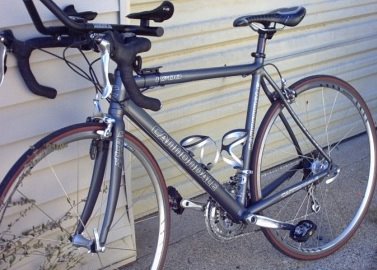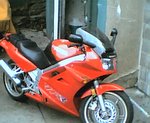Actual Laws regarding operation of Bicycles on Public Roads (if there was any confusion, there shouldn't be any now)
169.222 Operation of bicycle.
Subdivision 1. Traffic laws apply. Every person operating a bicycle shall have all of the rights and duties applicable to the driver of any other vehicle by this chapter, except in respect to those provisions in this chapter relating expressly to bicycles and in respect to those provisions of this chapter which by their nature cannot reasonably be applied to bicycles.
Subd. 2. Manner and number riding. No bicycle shall be used to carry more persons at one time than the number for which it is designed and equipped, except (1) on a baby seat attached to the bicycle, provided that the baby seat is equipped with a harness to hold the child securely in the seat and that protection is provided against the child's feet hitting the spokes of the wheel or (2) in a seat attached to the bicycle operator.
Subd. 3. Clinging to vehicle. Persons riding upon any bicycle, coaster, roller skates, toboggan, sled, skateboard, or toy vehicle shall not attach the same or themselves to any street car or vehicle upon a roadway.
Subd. 4. Riding on roadway or shoulder. (a) Every person operating a bicycle upon a roadway shall ride as close as practicable to the right-hand curb or edge of the roadway except under any of the following situations:
(1) when overtaking and passing another vehicle proceeding in the same direction;
(2) when preparing for a left turn at an intersection or into a private road or driveway;
(3) when reasonably necessary to avoid conditions, including fixed or moving objects, vehicles, pedestrians, animals, surface hazards, or narrow width lanes, that make it unsafe to continue along the right-hand curb or edge.
(b) If a bicycle is traveling on a shoulder of a roadway, the bicycle shall travel in the same direction as adjacent vehicular traffic.
(c) Persons riding bicycles upon a roadway or shoulder shall not ride more than two abreast and shall not impede the normal and reasonable movement of traffic and, on a laned roadway, shall ride within a single lane.
(d) A person operating a bicycle upon a sidewalk, or across a roadway or shoulder on a crosswalk, shall yield the right-of-way to any pedestrian and shall give an audible signal when necessary before overtaking and passing any pedestrian. No person shall ride a bicycle upon a sidewalk within a business district unless permitted by local authorities. Local authorities may prohibit the operation of bicycles on any sidewalk or crosswalk under their jurisdiction.
(e) An individual operating a bicycle or other vehicle on a bikeway shall leave a safe distance when overtaking a bicycle or individual proceeding in the same direction on the bikeway, and shall maintain clearance until safely past the overtaken bicycle or individual.
(f) A person lawfully operating a bicycle on a sidewalk, or across a roadway or shoulder on a crosswalk, shall have all the rights and duties applicable to a pedestrian under the same circumstances.
Subd. 5. Carrying articles. No person operating a bicycle shall carry any package, bundle, or article which prevents the driver from keeping at least one hand upon the handle bars or from properly operating the brakes of the bicycle.
Subd. 6. Bicycle equipment. (a) No person shall operate a bicycle at nighttime unless the bicycle or its operator is equipped with a lamp which shall emit a white light visible from a distance of at least 500 feet to the front and with a red reflector of a type approved by the Department of Public Safety which is visible from all distances from 100 feet to 600 feet to the rear when directly in front of lawful lower beams of headlamps on a motor vehicle. No person may operate a bicycle at any time when there is not sufficient light to render persons and vehicles on the highway clearly discernible at a distance of 500 feet ahead unless the bicycle or its operator is equipped with reflective surfaces that shall be visible during the hours of darkness from 600 feet when viewed in front of lawful lower beams of headlamps on a motor vehicle. The reflective surfaces shall include reflective materials on each side of each pedal to indicate their presence from the front or the rear and with a minimum of 20 square inches of reflective material on each side of the bicycle or its operator. Any bicycle equipped with side reflectors as required by regulations for new bicycles prescribed by the United States Consumer Product Safety Commission shall be considered to meet the requirements for side reflectorization contained in this subdivision. A bicycle may be equipped with a rear lamp that emits a red flashing signal.
(b) No person shall operate a bicycle unless it is equipped with a brake which will enable the operator to make the braked wheels skid on dry, level, clean pavement.
(c) No person shall operate upon a highway any bicycle equipped with handlebars so raised that the operator must elevate the hands above the level of the shoulders in order to grasp the normal steering grip area.
(d) No person shall operate upon a highway any bicycle which is of such a size as to prevent the operator from stopping the bicycle, supporting it with at least one foot on the highway surface and restarting in a safe manner.
Subd. 7. Sale with reflectors and other equipment. No person shall sell or offer for sale any new bicycle unless it is equipped with reflectors and other equipment as required by subdivision 6, clauses (a) and (b) and by the regulations for new bicycles prescribed by the United States Consumer Product Safety Commission.
Subd. 8. Turning, lane change. An arm signal to turn right or left shall be given continuously during the last 100 feet traveled by the bicycle before turning, unless the arm is needed to control the bicycle, and shall be given while the bicycle is stopped waiting to turn.
Subd. 9. Bicycle parking. (a) A person may park a bicycle on a sidewalk unless prohibited or restricted by local authorities. A bicycle parked on a sidewalk shall not impede the normal and reasonable movement of pedestrian or other traffic.
(b) A bicycle may be parked on a roadway at any location where parking is allowed if it is parked in such a manner that it does not obstruct the movement of a legally parked motor vehicle.
Subd. 10. Bicycle events. (a) Bicycle events, parades, contests, or racing on a highway shall not be unlawful when approved by state or local authorities having jurisdiction over that highway. Approval shall be granted only under conditions which assure reasonable safety for all participants, spectators and other highway users, and which prevent unreasonable interference with traffic flow which would seriously inconvenience other highway users.
(b) By agreement with the approving authority, participants in an approved bicycle highway event may be exempted from compliance with any traffic laws otherwise applicable thereto, provided that traffic control is adequate to assure the safety of all highway users.
Subd. 11. Peace officer operating bicycle. The provisions of this section governing operation of bicycles do not apply to bicycles operated by peace officers while performing their duties.
HIST: 1978 c 739 s 12; 1986 c 444; 1987 c 255 s 14; 1993 c 326 art 4 s 2; art 7 s 2; 1995 c 72 s 2
Copyright 2004 by the Office of Revisor of Statutes, State of Minnesota.
Subscribe to:
Post Comments (Atom)




2 comments:
shit! you just reminded me that i have to renew my bike license!
funny how the most unexpected things remind you of something!
Aint it the truth though!
Post a Comment